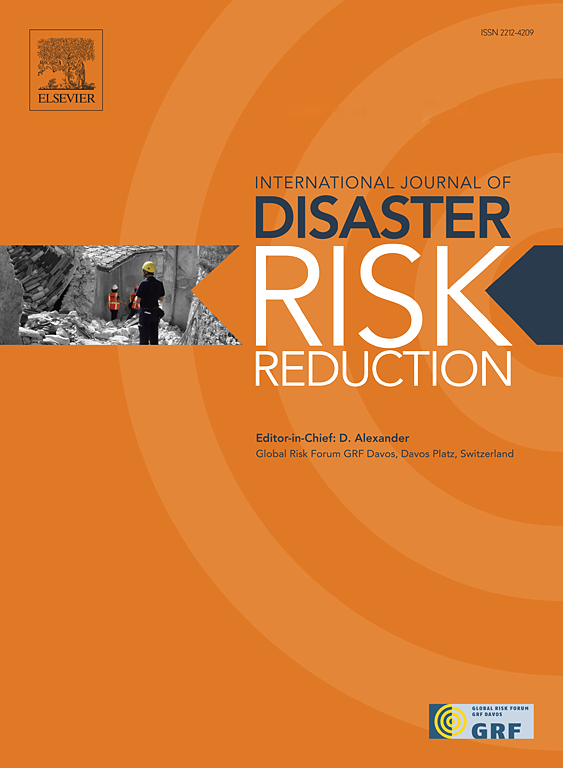量化巴基斯坦伊斯兰堡易发洪灾社区的城市适应规划:基于指数的方法
IF 4.5
1区 地球科学
Q1 GEOSCIENCES, MULTIDISCIPLINARY
International journal of disaster risk reduction
Pub Date : 2025-08-12
DOI:10.1016/j.ijdrr.2025.105762
引用次数: 0
摘要
由于气候变化和不受控制的城市化,城市洪水风险增加。从社区的角度对适应性规划概念的概念化和量化认识有限。本研究通过提出洪水易发城市社区适应性规划指标填补了这一空白。本研究选择了巴基斯坦伊斯兰堡的三个城市社区。采用结构化问卷法对600户家庭进行抽样调查。感知适应计划从两个角度进行测量。基于维度的适应规划指数(D-API)用于衡量对行为、结构和生态适应规划维度的认知,而基于组件的适应规划指数(C-API)用于评估意识、意愿和自我效能。这些指数是根据与巴基斯坦伊斯兰堡城市洪水风险景观相关的特定背景的社会经济和适应性规划指标制定的。相关分析显示,适应维度之间存在较强的相关性,适应成分之间存在中等的相关性。多元回归分析确定了影响适应规划的社会经济因素。结果表明,群落对生态适应规划措施具有更高的认知和信任度。意愿和自我效能的平均值较高。受教育程度和洪水经历对适应规划有正向影响,而年龄、家庭规模、老年人数量和收入来源对适应规划有负向影响。拟议的指数可以帮助发展从业者、规划者、决策者和灾害管理者验证他们当前和拟议的洪水适应战略。该指数可根据当地情况和灾害类型进行定制,以有效降低城市地区的风险并进行适应性规划。本文章由计算机程序翻译,如有差异,请以英文原文为准。
Quantifying urban adaptation planning in flood-prone communities of Islamabad, Pakistan: An index-based approach
Urban flood risks have increased due to climate change and uncontrolled urbanization. There is a limited understanding regarding the conceptualization and quantification of the adaptation planning concept from a community perspective. This study fills the gap by proposing an adaptation planning index for flood-prone urban communities. Three urban communities in Islamabad, Pakistan, were selected for this study. A sample of 600 households was collected using structured questionnaires. Perceived adaptation planning was measured from two perspectives. The Dimension-based Adaptation Planning Index (D-API) was used to measure perceptions regarding behavioral, structural, and ecological adaptation planning dimensions, while the Component-based Adaptation Planning Index (C-API) evaluated awareness, willingness, and self-efficacy. The indexes were developed based on context-specific socioeconomic and adaptation planning indicators relevant to the urban flood risk landscape in Islamabad, Pakistan. Correlation analysis revealed a strong correlation among the adaptation dimensions and a moderate correlation among adaptation components. Multiple regression analysis identified socioeconomic factors that affect adaptation planning. The results indicate that the communities possess greater knowledge of and trust in ecological adaptation planning measures. High mean values were observed for willingness and self-efficacy. Education level and previous flood experience positively influenced adaptation planning, while age, household size, number of elderly members, and sources of income had a negative influence. The proposed index can assist development practitioners, planners, policymakers, and disaster managers in validating their current and proposed flood adaptation strategies. The index can be customized according to local conditions and hazard type for effective risk reduction and adaptation planning for urban areas.
求助全文
通过发布文献求助,成功后即可免费获取论文全文。
去求助
来源期刊

International journal of disaster risk reduction
GEOSCIENCES, MULTIDISCIPLINARYMETEOROLOGY-METEOROLOGY & ATMOSPHERIC SCIENCES
CiteScore
8.70
自引率
18.00%
发文量
688
审稿时长
79 days
期刊介绍:
The International Journal of Disaster Risk Reduction (IJDRR) is the journal for researchers, policymakers and practitioners across diverse disciplines: earth sciences and their implications; environmental sciences; engineering; urban studies; geography; and the social sciences. IJDRR publishes fundamental and applied research, critical reviews, policy papers and case studies with a particular focus on multi-disciplinary research that aims to reduce the impact of natural, technological, social and intentional disasters. IJDRR stimulates exchange of ideas and knowledge transfer on disaster research, mitigation, adaptation, prevention and risk reduction at all geographical scales: local, national and international.
Key topics:-
-multifaceted disaster and cascading disasters
-the development of disaster risk reduction strategies and techniques
-discussion and development of effective warning and educational systems for risk management at all levels
-disasters associated with climate change
-vulnerability analysis and vulnerability trends
-emerging risks
-resilience against disasters.
The journal particularly encourages papers that approach risk from a multi-disciplinary perspective.
 求助内容:
求助内容: 应助结果提醒方式:
应助结果提醒方式:


